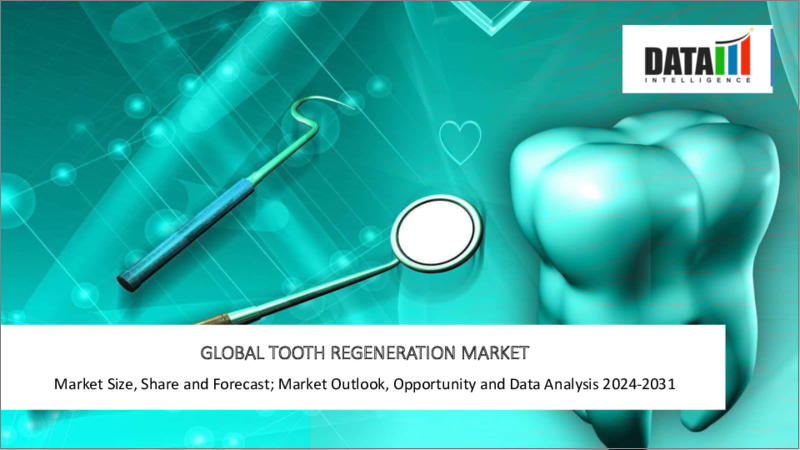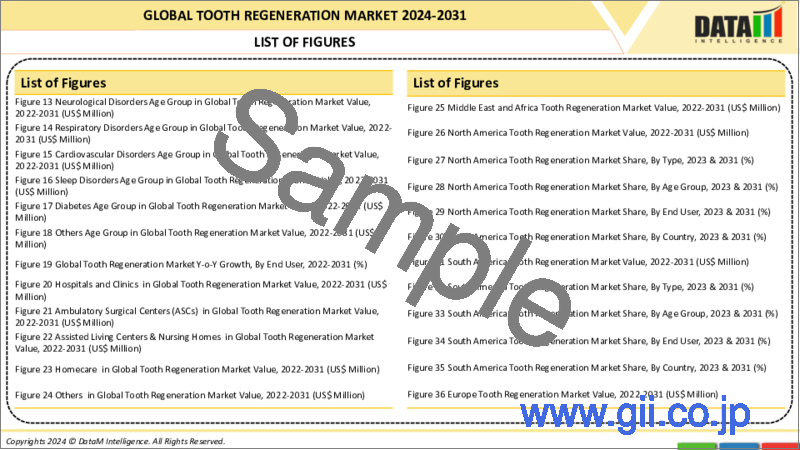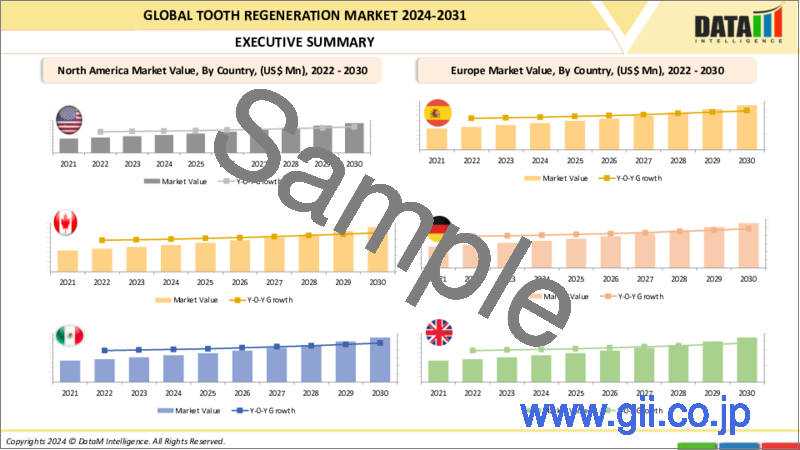|
|
市場調査レポート
商品コード
1279710
歯の再生の世界市場- 2023-2030年Global Tooth Regeneration Market - 2023-2030 |
||||||
カスタマイズ可能
適宜更新あり
|
|||||||
| 歯の再生の世界市場- 2023-2030年 |
|
出版日: 2023年05月26日
発行: DataM Intelligence
ページ情報: 英文 195 Pages
納期: 即日から翌営業日
|
- 全表示
- 概要
- 目次
市場概要
歯の再生の世界市場は、2022年に41億6,950万米ドルに達し、2030年には最大65億9,350万米ドルに達することで有利な成長が予測されています。世界の歯の再生市場は、予測期間中(2023年~2030年)に6.0%のCAGRを示すと予測されています。
歯の不調や欠陥の有病率の増加が市場拡大の主要な促進要因となっています。分化を制御し、幹細胞の発現パターンを特定することで、完全な歯の再生が可能になります。市場の開拓は、新しい有利な歯の再生技術の研究開発によって支えられています。
歯の再生市場の応用範囲は、歯髄、エナメル質、象牙質の歯の再生からなり、歯の再生の市場シェアを高めています。また、歯の欠損に対する再生治療もますます盛んになっており、口腔歯科の分野では広範な研究の対象となっています。歯の再生の開発および各国での医療認可の予定も、市場成長への明るい展望を生み出しています。
市場力学
発生生物学の進歩と調査研究の増加が、歯の再生市場の成長を促進する
生物学とバイオインフォマティクスを応用し、歯の発生過程における遺伝子発現の順序を特定した上で、様々な制御解除メカニズムを採用することにより、空間的・時間的に特定の発現の創出を狙い、歯の再生という予想される目的を達成することが可能です。さらに、歯組織の再生や歯器官全体の再生に関する研究も、現在のトレンドとなっています。
技術的に進歩した新しい治療法の増加により、メーカーに有利なビジネスチャンスが生まれる
主要企業が最先端の技術改良のために研究開発能力に多額の投資をしているため、新興国市場には好機が広がっています。市場に影響を与えるもう一つの動向は、歯の再生治療に対する需要の高まりです。
世界保健機関(WHO)によると、口腔疾患は多くの国にとって大きな健康負担となっており、痛み、苦しみ、醜い姿、さらには死をもたらすなど、人々に生涯にわたる影響を及ぼしています。これは、完全に予防可能であるにもかかわらずです。約35億人の人々が口腔の病気の影響を受けると予想されています。また、歯の再生治療に対する高い需要も、この業界を牽引しています。
極めて一般的な病状である歯の変形は、世界中で何百万人もの人々に影響を及ぼしています。失った歯を補うために歯科インプラントが、歯髄壊死を治すために歯内療法が、そして虫歯を治すために詰め物が使われます。これらの手術はすべて、使用される合成材料の年齢層に左右されます。
一方、医科歯科分野の組織工学・再生医歯学(TERMD)は、必要な組織の再生に生物学的な治療法を用い、結果として生体組織を再生する能力を有しています。このように、技術開発のスピードが加速しているため、予測期間中に市場が拡大すると予測されています。
再生療法のデメリットと高コストが市場成長の妨げになる
再生治療の高額な費用、様々な再生技術の数多くの欠点、歯の再生治療を生み出す主要なキープレーヤーが争わなければならない厳しい規制などが、市場に影響を与えています。
再生歯科治療で最も困難なのは、歯周病の治療です。歯周病は複雑でよくわからない組織であるため、歯周病を「治療」するための再生アプローチを用いた有効な応用例は、現在のところほとんど記録されていないです。大臼歯の治療において、再生歯内療法は、アクセス腔や根管の黒ずみ、根管石灰化によるアクセス制限、MTA除去の課題など、多くの制限があります。
再生治療の欠点は、組織がどこから来たのかが不明なことです。研究者によると、効果的な細胞の密度と構成は、組織工学にとって極めて重要です。これらの細胞はフィブリン塊に捕捉されるため、研究者は組織工学の活性化のために血栓の発生に依存しないです。治療の効果は、細胞の化学組成と量のばらつきによって左右されます。
COVID-19影響分析
COVID-19の分析には、Pre-COVIDシナリオ、COVIDシナリオ、Post-COVIDシナリオに加え、価格力学(パンデミック中と後の価格変化を含む)、需給スペクトル(取引制限、ロックダウン、その後の問題による需要と供給のシフト)、政府の取り組み(政府機関による市場、産業、部門の活性化の取り組み)、メーカーの戦略的取り組みが含まれています。
ロシア・ウクライナ紛争影響分析
ロシア・ウクライナ紛争は、この地域の主要な市場プレイヤーの数が少ないため、世界の歯の再生市場に与える影響は少ないと推測されます。しかし、原材料の輸出入の影響は、予測期間中、世界の歯の再生市場の成長にほとんど影響を及ぼさないと予想されます。
目次
第1章 調査手法と範囲
- 調査手法
- 調査目的および調査範囲
第2章 定義と概要
第3章 エグゼクティブサマリー
- アプリケーション別スニペット
- 年齢層別スニペット
- エンドユーザー別スニペット
- 地域別スニペット
第4章 市場力学
- 影響要因
- 促進要因
- 発生生物学の進展と調査研究の増加
- 歯の欠陥の有病率の上昇
- 抑制要因
- 再生治療のデメリットと高いコスト
- 機会
- 技術的に進歩した新しい治療法の成長
- 影響分析
- 促進要因
第5章 産業分析
- ポーターの5フォース分析
- サプライチェーン分析
- 価格分析
- 法規制の分析
第6章 COVID-19の分析
- COVID-19の分析
- COVID-19の前のシナリオ
- COVID-19期間中のシナリオ
- COVID-19後のシナリオと今後のシナリオ
- COVID-19の中での価格・ダイナミクス
- 需給スペクトル
- パンデミック時の市場に関連する政府の取り組み
- メーカーの戦略的な取り組み
- サマリー
第7章 用途別
- エナメル
- 象牙質
- パルプ
- 歯周組織
- その他
第8章 年齢層別
- 老年
- 成人
- 青少年期
第9章 エンドユーザー別
- 病院
- 専門医院
- 学術・研究機関
- その他
第10章 地域別
- 北米
- 米国
- カナダ
- メキシコ
- 欧州
- ドイツ
- 英国
- フランス
- イタリア
- スペイン
- その他欧州
- 南米
- ブラジル
- アルゼンチン
- その他南米地域
- アジア太平洋地域
- 中国
- インド
- 日本
- その他アジア太平洋地域
- 中東・アフリカ地域
- 地域別の主なダイナミクス
第11章 競合情勢
- 競合シナリオ
- 市況ポジショニング/シェア分析
- M&A(合併・買収)分析
第12章 企業プロファイル
- Institut Straumann AG
- 会社概要
- アプリケーションのポートフォリオと説明
- 財務概要
- 主な発展状況
- Dentsply Sirona
- Datum Dental
- Unilever
- 3M
- BioHorizons
- Wright Medical Group N.V.
第13章 付録
Market Overview
The global tooth regeneration market reached US$ 4,169.5 million in 2022 and is projected to witness lucrative growth by reaching up to US$ 6,593.5 million by 2030. The global tooth regeneration market is expected to exhibit a CAGR of 6.0% during the forecast period (2023-2030).
The increased prevalence of dental infirmity or defects is a key driver of market expansion. Controlled differentiation and specific stem cell expression patterns can enable complete tooth regeneration. Rising market expansion is being supported by research and development of new advantageous tooth regeneration technology.
The tooth regeneration market's application scope comprises tooth regeneration for pulp, enamel, and dentin, which has increased the market share for tooth regeneration. Regenerative therapy for tooth defects is also becoming increasingly popular and is the subject of extensive research in the field of oral dentistry. Tooth regeneration developments and their upcoming medical approvals across countries are also creating a positive outlook for market growth.
Market Dynamics
Advances in Developmental Biology and Increasing Research Studies Drive the Growth of the Tooth Regeneration Market
It is feasible to target the creation of spatial-temporal particular expression and achieve the anticipated objective of tooth regeneration by employing a variety of control release mechanisms after applying biology and bioinformatics to identify the sequence of gene expression while tooth development. Furthermore, the regeneration of tooth tissue and studies on the regeneration of a full tooth organ are current trending topics.
Growing Novel Technologically Advanced Therapies Creates Lucrative Opportunities for Manufacturers
Due to key players' significant investments in research and development capabilities for cutting-edge technical improvements, there is a developing market opportunity. Another trend influencing the market is the growing demand for tooth regeneration treatments.
According to the World Health Organization, oral diseases constitute a huge health burden for many countries and have a lifetime impact on people, causing pain, suffering, disfigurement, and even death. This is despite the fact that they are completely preventable. It is anticipated that nearly 3.5 billion people will be affected by oral illnesses. The industry is also being driven by the high demand for tooth regeneration treatments.
An extremely common medical condition, tooth deformities affect millions of people worldwide. Dental implants are used to replace lost teeth, endodontic therapy is used to cure pulp necrosis, and fillings are used to fix cavities. All of these operations depend on the age group of the synthetic materials used.
The medical and dental fields of tissue engineering & regenerative medicine and dentistry (TERMD) on the other hand, use biologically based therapeutic methods for necessary tissue regeneration, and as a result, have the ability to regenerate living tissues. Due to the accelerating speed of technological development, it is therefore projected that the market would increase over the projection period.
The Disadvantages and High Cost of Regenerative Therapy will Hamper the Growth of Market
The high cost of regenerative therapy, numerous drawbacks of various regeneration techniques, and onerous regulations that the primary key players for creating tooth regenerative treatments must contend with are all having an effect on the market.
The most challenging aspect of regenerative dentistry is treating periodontal diseases. As periodontium is a complex and poorly understood tissue, there are currently few documented effective applications using regenerative approaches to "treat" periodontal disease. For the treatment of molars, the regenerative endodontic technique has a number of limitations, notably darkening of the access cavity or root canal, restricted access due to canal calcification, and challenges with MTA removal.
One disadvantage of the revascularization strategy is that it is unclear where the tissue came from initially. Effective cell density and composition, according to researchers, are crucial for tissue engineering. Because these cells are trapped in fibrin clots, researchers are not reliant upon blood clot generation for tissue engineering activity. The effectiveness of the treatment will be influenced by the variations in the chemical composition and quantity of the cell.
COVID-19 Impact Analysis
The COVID-19 analysis includes the Pre-COVID Scenario, COVID Scenario, and Post-COVID Scenario in addition to pricing dynamics (including pricing change during and after the pandemic evaluating it with pre-COVID scenarios), demand-supply spectrum (shift in demand and supply due to trading restrictions, lockdown, and afterward issues), government initiatives (initiatives to reactivate a market, industry, or sector by government bodies), and manufacturers strategic initiatives.
Russia-Ukraine War Impact Analysis
The Russia-Ukraine conflict is estimated to have a low impact on the global tooth regeneration market, owing to the low number of key market players in this region. However, the impact of the import and export of raw materials is expected to have little influence over the global tooth regeneration market growth over the forecast period.
Segment Analysis
The global tooth regeneration market is segmented based on application, age group, end user and region.
Geriatric Segment Accounts for 40.2% of Market Share Owing to Rising Geriatric Population with Tooth Defects
According to World Health Organization, in 2022, there are 1.4 billion people over the age of 60, up from 1 billion in 2020. The number of individuals in the world who are 60 or older will double (to 2.1 billion) by 2050. Between 2020 and 2050, the number of people 80 or older is projected to treble, reaching 426 million.
Degenerative alterations affect older persons and get worse as they age. According to studies, many elderly persons don't get their teeth cleaned on a regular basis. They are more susceptible to common oral disorders such periodontal disease and dental caries, especially root caries. certain systemic issues and certain oral illnesses frequently coexist.
Geographical Analysis
North America Accounted for Approximately 37.6% of the Market Share Owing to the Strong Presence of Major Players and Increasing Technological Advancements
Manufacturers have chances to expand their operations in this region because of the rising demand for tooth regeneration for advancements in North America. This region has many producers and suppliers, and its rapid economic development has raised industrial production of tooth regeneration products, which has increased the demand.
North America has a large number of producers and suppliers, and as a result of the swift economic development of the area, industrial production has increased, fueling the demand of tooth regeneration applications. Rising new product launches for using tooth regeneration by key biopharmaceutical companies will drive the market growth.
Growth is also fueled by the rising technological advancements, regulatory approvals and novel product launches. Reseaerchers are becoming more aware of various kinds of regeneration methods, leading to the expansion of the market in this region. These factors shows the dominance of North America.
Competitive Landscape
The major global players in the tooth regeneration market include: Institut Straumann AG, Dentsply Sirona, Datum Dental, Ltd., Unilever, 3M, Integra LifeSciences, BioHorizons and Wright Medical Group N.V. among others.
Why Purchase the Report?
- To visualize the global tooth regeneration market segmentation based on application, age group, end user and region, as well as understand key commercial assets and players.
- Identify commercial opportunities by analyzing trends and co-development.
- Excel data sheet with numerous data points of tooth regeneration market-level with all segments.
- PDF report consists of a comprehensive analysis after exhaustive qualitative interviews and an in-depth study.
- Product mapping available as Excel consisting of key products of all the major players.
The global tooth regeneration market report would provide approximately 53 tables, 54 figures and 195 Pages.
Target Audience 2023
- Manufacturers/ Buyers
- Industry Investors/Investment Bankers
- Research Professionals
- Emerging Companies
Table of Contents
1. Methodology and Scope
- 1.1. Research Methodology
- 1.2. Research Objective and Scope of the Report
2. Definition and Overview
3. Executive Summary
- 3.1. Snippet by Application
- 3.2. Snippet by Age Group
- 3.3. Snippet by End User
- 3.4. Snippet by Region
4. Dynamics
- 4.1. Impacting Factors
- 4.1.1. Drivers
- 4.1.1.1. Advances in developmental biology and increasing research studies
- 4.1.1.2. Rising prevalence of dental defects
- 4.1.2. Restraints
- 4.1.2.1. The disadvantages and high cost of regenerative therapy
- 4.1.3. Opportunity
- 4.1.3.1. Growing novel technologically advanced therapies
- 4.1.4. Impact Analysis
- 4.1.1. Drivers
5. Industry Analysis
- 5.1. Porter's 5 Forces Analysis
- 5.2. Supply Chain Analysis
- 5.3. Pricing Analysis
- 5.4. Regulatory Analysis
6. COVID-19 Analysis
- 6.1. Analysis of COVID-19
- 6.1.1. Scenario Before COVID-19
- 6.1.2. Scenario During COVID-19
- 6.1.3. Post COVID-19 & Future Scenario
- 6.2. Pricing Dynamics Amid COVID-19
- 6.3. Demand-Supply Spectrum
- 6.4. Government Initiatives Related to the Market During Pandemic
- 6.5. Manufacturers Strategic Initiatives
- 6.6. Conclusion
7. By Application
- 7.1. Introduction
- 7.1.1. Market Size Analysis and Y-o-Y Growth Analysis (%), By Application
- 7.1.2. Market Attractiveness Index, By Application
- 7.2. Enamel *
- 7.2.1. Introduction
- 7.2.2. Market Size Analysis and Y-o-Y Growth Analysis (%)
- 7.3. Dentin
- 7.4. Pulp
- 7.5. Periodontium
- 7.6. Others
8. By Age Group
- 8.1. Introduction
- 8.1.1. Market Size Analysis and Y-o-Y Growth Analysis (%), By Age Group
- 8.1.2. Market Attractiveness Index, By Age Group
- 8.2. Geriatric *
- 8.2.1. Introduction
- 8.2.2. Market Size Analysis and Y-o-Y Growth Analysis (%)
- 8.3. Adults
- 8.4. Adolescence
9. By End User
- 9.1. Introduction
- 9.1.1. Market Size Analysis and Y-o-Y Growth Analysis (%), By End User
- 9.1.2. Market Attractiveness Index, By End User
- 9.2. Hospitals *
- 9.2.1. Introduction
- 9.2.2. Market Size Analysis and Y-o-Y Growth Analysis (%)
- 9.3. Specialty Clinics
- 9.4. Academic and Research institutes
- 9.5. Others
10. By Region
- 10.1. Introduction
- 10.1.1. Market Size Analysis and Y-o-Y Growth Analysis (%), By Region
- 10.1.2. Market Attractiveness Index, By Region
- 10.2. North America
- 10.2.1. Introduction
- 10.2.2. Key Region-Specific Dynamics
- 10.2.3. Market Size Analysis and Y-o-Y Growth Analysis (%), By Application
- 10.2.4. Market Size Analysis and Y-o-Y Growth Analysis (%), By Age Group
- 10.2.5. Market Size Analysis and Y-o-Y Growth Analysis (%), By End User
- 10.2.6. Market Size Analysis and Y-o-Y Growth Analysis (%), By Country
- 10.2.6.1. The U.S.
- 10.2.6.2. Canada
- 10.2.6.3. Mexico
- 10.3. Europe
- 10.3.1. Introduction
- 10.3.2. Key Region-Specific Dynamics
- 10.3.3. Market Size Analysis and Y-o-Y Growth Analysis (%), By Application
- 10.3.4. Market Size Analysis and Y-o-Y Growth Analysis (%), By Age Group
- 10.3.5. Market Size Analysis and Y-o-Y Growth Analysis (%), By End User
- 10.3.6. Market Size Analysis and Y-o-Y Growth Analysis (%), By Country
- 10.3.6.1. Germany
- 10.3.6.2. The U.K.
- 10.3.6.3. France
- 10.3.6.4. Italy
- 10.3.6.5. Spain
- 10.3.6.6. Rest of Europe
- 10.4. South America
- 10.4.1. Introduction
- 10.4.2. Key Region-Specific Dynamics
- 10.4.3. Market Size Analysis and Y-o-Y Growth Analysis (%), By Application
- 10.4.4. Market Size Analysis and Y-o-Y Growth Analysis (%), By Age Group
- 10.4.5. Market Size Analysis and Y-o-Y Growth Analysis (%), By End User
- 10.4.6. Market Size Analysis and Y-o-Y Growth Analysis (%), By Country
- 10.4.6.1. Brazil
- 10.4.6.2. Argentina
- 10.4.6.3. Rest of South America
- 10.5. Asia-Pacific
- 10.5.1. Introduction
- 10.5.2. Key Region-Specific Dynamics
- 10.5.3. Market Size Analysis and Y-o-Y Growth Analysis (%), By Application
- 10.5.4. Market Size Analysis and Y-o-Y Growth Analysis (%), By Age Group
- 10.5.5. Market Size Analysis and Y-o-Y Growth Analysis (%), By End User
- 10.5.6. Market Size Analysis and Y-o-Y Growth Analysis (%), By Country
- 10.5.6.1. China
- 10.5.6.2. India
- 10.5.6.3. Japan
Australia
- 10.5.6.4. Rest of Asia-Pacific
- 10.6. Middle East and Africa
- 10.6.1. Introduction
- 10.6.2. Key Region-Specific Dynamics
- 10.6.3. Market Size Analysis and Y-o-Y Growth Analysis (%), By Application
- 10.6.4. Market Size Analysis and Y-o-Y Growth Analysis (%), By Age Group
- 10.6.5. Market Size Analysis and Y-o-Y Growth Analysis (%), By End User
11. Competitive Landscape
- 11.1. Competitive Scenario
- 11.2. Market Positioning/Share Analysis
- 11.3. Mergers and Acquisitions Analysis
12. Company Profiles
- 12.1. Institut Straumann AG *
- 12.1.1. Company Overview
- 12.1.2. Application Portfolio and Description
- 12.1.3. Financial Overview
- 12.1.4. Key Developments
- 12.2. Dentsply Sirona
- 12.3. Datum Dental
- 12.4. Unilever
- 12.5. 3M
- 12.6. BioHorizons
- 12.7. Wright Medical Group N.V.
LIST NOT EXHAUSTIVE
13. Appendix
- 13.1. About Us and Services
- 13.2. Contact Us





